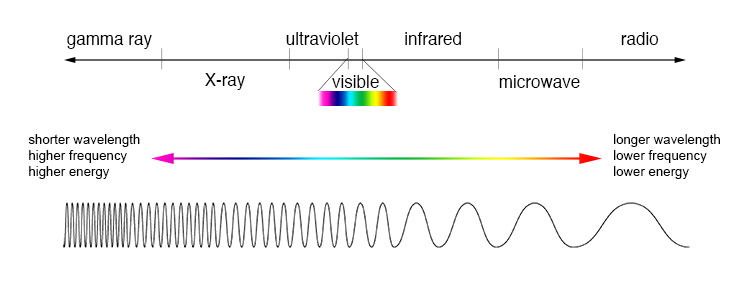Here we go...
First...Understand the basic electromagnetic spectrum, as illustrated above. The small fraction that is labeled 'visible' is where we, including animals, resides.
The above is how the current radar technology 'sees' a body, from a human to an aircraft, as a cluster of voltage spikes. A computer recognized there is a pattern inside that cluster of spikes and flagged it as a 'target'. That flag or alert is represented by a simple electronic 'dot' on a display. In other words, the computer actually 'sees' more than what it displays. What the radar computer 'sees' belongs to the right side of the EM scale.
Q: So why not display those spikes ?
A: Because the resolution is too coarse.
Basically, what the voltage spikes represents looks nothing like an aircraft. If a visual representation of something is that coarse, I do not want to spend any time looking at it and trying to deciper it. So if there is a pattern that looks close enough to an aircraft, just show me a dot and it will be enough.
But what happens if I can create freqs that are closer -- shift left -- to the 'visible' area ?
What Wavelength Goes With a Color?
Radars operates in the centimetric (cm) and millimetric (mm) range, or the right side of the scale. Some may even go giga-hertz (ghz).
The visible spectrum requires freqs -- physical wavelengths -- of tera-hertz or physical wavelengths of
NANO-METERS range.
What happens is that the radar computer will still see spikes, except this time, those spikes will be magnitudinally more complex, even too the point that I will be able to recognize an aircraft.
What the Russians are claiming is that they have a radar capable of creating nano-meters scale freqs, thereby producting near photographic level quality of an image of any body.
This is a bold claim.
It is bold in the sense that in radar detection,
YOU are the owner of the detection medium. The detection medium is electromagnetic (EM) radiation. We are the owners in the sense that we generate EM radiation at will, then we focus in a particular direction, and whatever returns we process it.
That is
NOT how vision works.
If you see a red ball, it is not your eyes that created the EM radiation that the ball reflected to the physical wavelength of the color red. Rather, the ball reflects light from other sources that give the human eye the color red. The Moon reflects light from the Sun and the Earth. You do not own the detection medium.
But now imagine your eyes, like Superman's x-ray vision, generating EM radiation in a very coherent manner, like a laser beam, then direct that beam anywhere you want and receives human-like vision. In this case, you own the detection medium.
The Russians have effectively claimed they created an electronic eye. Not a bionic eye because a bionic eye require organic matter. But an electronic eye. In the sky. Queue
The Alan Parsons Project 'Eye In The Sky' music.
Personally, I would not put too much stock on the claim that the PAK fighter will have this new fandango radar. Under laboratory conditions, a competent university can create nm scale EM signals.
On the other hand, this is the Russians. They surprised US with Sputnik. It was a Russian -- Pyotr Ufimtsev -- who gave US the math that we used to create the F-117. If what the Russians claimed is true, it would be like comparing Sputnik to the Space Shuttle. It will mean a quantum leap in radar detection technology.



 )
)




